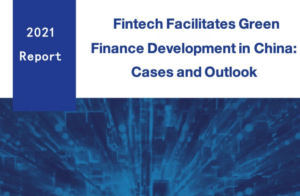Green Finance Center, Paulson Institute
 How can digital financial technologies be leveraged to support China’s green development? A new report from the Paulson Institute and the Institute of Finance and Sustainability suggests some answers. Fintech and Sustainable Development of Green Finance, offers key recommendations and includes two case studies of Chinese firms going green by integrating different financial technologies into their operations.
How can digital financial technologies be leveraged to support China’s green development? A new report from the Paulson Institute and the Institute of Finance and Sustainability suggests some answers. Fintech and Sustainable Development of Green Finance, offers key recommendations and includes two case studies of Chinese firms going green by integrating different financial technologies into their operations.
The report builds off of the Paulson Institute’s March 2020 fintech report—Fintech Facilitates the Sustainable Development of Green Finance in China.
—
The report profiles the Harvest Fund, one of China’s largest mutual fund companies and one of the earliest fund management companies established in the country.
In 2018, the Harvest Fund developed a fintech-enabled rating system that addresses some of the core obstacles to Environmental, Social, Governance (ESG) investing in China—lack of quality data and globally incompatible regulatory and standards requirements. The system is the first of its kind in China.
How it works:
- The system uses artificial intelligence to extract data—from 5,000 national, provincial, municipal, and county governments; over 2,300 local financial and news media outlets; and some 200 plus charity organizations—related to China’s ESG market trends;
- It provides ESG ratings for all companies considered A-shares;
- It integrates China’s own regulatory and standards requirements with other globally recognized ESG frameworks.
The upshot is the Harvest ESG rating system aims to provide global investment institutions with an ESG assessment tool tailored to the Chinese market at a time when sustainable investing is growing rapidly in the country.
What to watch:
The Harvest ESG rating system will be included in the Bloomberg Data Feed Scores in the second quarter of 2021, making it the first Chinese-developed ESG scores featured on an international financial terminal.
—
Another case study included in the report explores Huadian Corporation, the third-largest power generation company in the world and one of the top five state-owned power generation companies in China.
Huadian launched its Carbon Emissions Management System in August 2019 in preparation for the launch of China’s long-awaited national carbon market.
How it works:
- The system uses big data to support carbon emissions-related work across all levels at Huadian—from executive management at headquarters to the staff levels of its second and third-tier subsidiaries across the country.
- It manages carbon emissions data of all 30 directly-affiliated units and more than 110 thermal power generation companies of Huadian.
- It addresses the company’s needs in terms of carbon emissions data management, China Certified Emissions Reductions (CCER) project management, carbon allowance compliance, and carbon trading.
- It complies with the existing, though disparate, rules of the pilot carbon markets and is designed to meet the national carbon market registration and trading system requirements.
The upshot is a powerful system that expedites the company’s green and low-carbon transition through fintech solutions, providing an example for others in the power generation industry.
What to watch:
As China’s national carbon market comes online and expands to include industrial sectors like buildings, steel, and aluminum, Huadian’s carbon emissions management system can model best practices. These lessons will be instructional for power companies at provincial levels and for big industrial groups of other sectors when they enter into the national emissions trading scheme in due course.
—
The big picture:
Chinese companies will need to take aggressive action to meet the country’s green goals. China pledged to peak its carbon emissions by 2030 and achieve carbon neutrality by 2060. Digital financial technologies offer critical tools for greening the financial system and advancing China’s path to net-zero.
—
Read more:
Fintech Drives Sustainable Development in China—2020 Report
2020 Fintech Report Case Studies
How Fintech is Transforming Green Finance
Green Finance Helps China’s Small & Mid-Sized Businesses
How a Local Chinese Bank Used Fintech to Go Green
A Fintech Solution for Climate Risk Assessment



